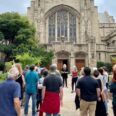
Staff from the Pasadena Department of Transportation started placing “traffic calming” signs along the city’s major roads Tuesday to remind drivers to slow down for neighbors who may be walking, running, or bicycling to stay active as the state’s “Safer At Home” order continues to be in effect.
The city announced last week it was putting in place a number of strategies to enhance safety for all road users during the COVID-19 emergency, including placing “Slow Down” signage at the entrances to residential neighborhoods throughout Pasadena to keep pedestrians safe and help maintain social distancing.
Sign deployment will be completed citywide in May, the city said, and signs will be in place until the order is lifted and public parks and recreation centers reopen to the public.
All local streets will remain open and accessible to traffic, since essential workers need to get to and from work, deliveries have to be made, and residents have to make essential trips, the Transportation Department said.
“Roughly 500 signs will be installed throughout the city, creating a network of over 100 miles of Slow Streets, and we’ll be relying on residents’ feedback to optimize placement of these signs,” Pasadena Transportation Director Laura Cornejo said.
The department said they will also launch a “Walk Local, Bike Solo” cross-channel social media campaign on Facebook, Instagram, and Twitter beginning April 27 to promote self-guided neighborhood tours, encourage residents to support local restaurants, and share COVID-19 health and safety reminders.
This campaign will be managed through local non-profit organization Day One. For more information, visit www.walklocalbikesolo.com.
Starting Wednesday, April 29, traffic signal timing along 10 major corridors will be operating in “nighttime mode,” also known as “free mode,” all day in an effort to reduce motorist speed and enhance safety.
In this mode, traffic at intersections is served on a first-come, first-served principal. Select signals will remain red until traffic – whether pedestrian, motorist or bicyclist – approaches the intersection. Once traffic approaches, the signal changes within seconds. Pairing the free operation with rest-in-red will require vehicles to slow down or stop at certain intersections.
The Transportation Department said the “free mode” operation all day will be implemented along at least 10 corridors and intersections in the City. They will then determine if this type of signal operation should be extended to other corridors around Pasadena.
“This three-tiered campaign is a reminder that roads are multi-modal and are meant to be safely shared by all,” Cornejo said. “After it’s implemented, we’ll monitor and modify our efforts as needed.”


















